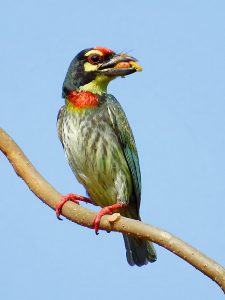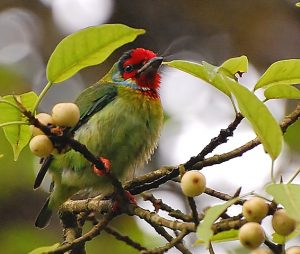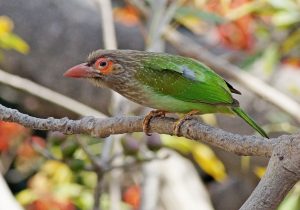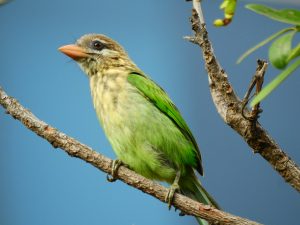Asian Barbets (Megalaimidae)
Asian Barbets (Megalaimidae)
Asian barbets are small, colourful birds frequently found in forests and other green patches. India is home to nine barbet species. Barbets are named for the bristles at the bases of their stout, sharp bills. They are big-headed, short-tailed birds. They call loudly, jerking the head or tail.
Diet
They are mainly frugivorous and feeds on figs, berries and wild fruits, they are also known to prey on a wide range of insects.
Behaviour
Asian barbets are usually birds of the inner forest. One species, the Coppersmith Barbet, is adapted to live in the forest edge and in scrub.
Reproduction
The nest is a hole, dug with the beak, high up in a rotting tree or in a termite nest. Usually 2 to 4 eggs are laid and is incubated for 13 – 15 days.
Did you know?
- The beak remains shut during each call – a patch of bare skin on both sides of the throat inflates and collapses with each call and the head is bobbed.
- Barbets play a vital role in seed dispersal there by enabling forests to flourish and grow.
Coppersmith Barbet (Psilipogon haemacephalus)
Description
A broad crimson patch is present on the bird’s forehead and breast. Its chin, throat and patch below and above eyes are bright yellow. Hind crown and sides of head are black. A yellow band occurs below the crimson breast. Remainder of the upper plumage is grass green tinged with greyish on the back. Lower plumage is pale yellow, streaked broadly with green. Tail is lightly washed below with verditer blue.
Sexual dimorphism – Sexes are alike.
Distribution – Widely distributed throughout India from about 1000m in outer foot-hills of Himalayas, right down to South. Not found in some parts of South Kerala.

 Malabar barbet (Psilopogon malabaricus)
Malabar barbet (Psilopogon malabaricus)
Description
It is a green barbet with diagnostic red over its entire face, forehead, throat, and breast. It has a diffuse blue band on the sides of the head and breast, while a thick black traverse band separates the blue parts from the red. Some faint streaking visible below on an otherwise green ground color. Also known as Crimson-throated Barbets, they have a distinct black stripe around their eyes and a black crown as well.
Sexual dimorphism – Sexes are alike.
Distribution
This species is found in the Western Ghats from around Goa south to southern Kerala in moist evergreen forest mainly below 1200 m elevation.
Brown-headed Barbet (Psilopogon zeylanicus)

Description
It is identified by its green and brown colours with prominent pale streaks on its brown head and breast. The brown throat and green wings with white speckling
on the shoulders are characteristic of this species, along with a distinct yellow disc around its eyes. The brown-yellow bill turn orange-red when breeding.
Sexual dimorphism – Sexes are alike.
Distribution
It is native to the Indian subcontinent, where it inhabits tropical and subtropical moist broadleaf forests.
White-cheeked barbet (Psilopogon viridis)
Description
This green barbet has a dark brown head and characteristic white patterns on its face. A white patch occurs around the ear-coverts, a white line above the eye, and a white throat. Also the brown neck and breast has got white streaks.
Sexual dimorphism – Sexes are alike.
Distribution
It is found only in southern India.
